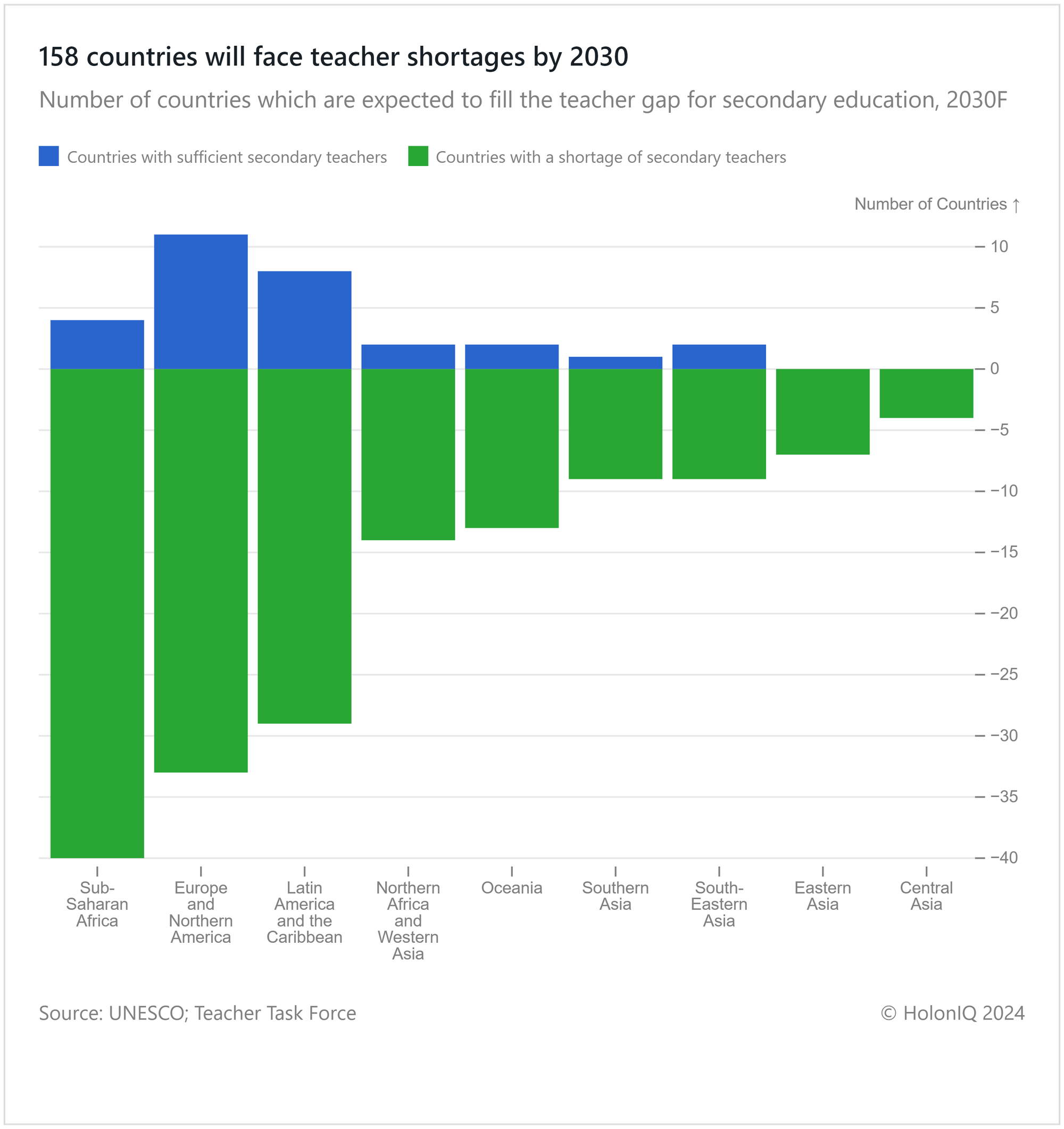📚 158 Countries Face Teacher Shortages. Clean Tech Investments. Opioid Epidemic. China’s Population.
Chart of the Day #100 looks at Global Teacher Shortages, Clean Tech Investments, Global Drug Usage Patterns, and China’s Population Forecast.
Welcome to Chart of the Day #100!
We're charting our 100th visual journey today! We hope our charts have provided valuable insights and sparked your curiosity. Stay tuned for more. For unlimited access to over one million charts, request a demo.
Today's Topics
📚 Teacher Shortage. 158 countries to face teacher shortages in secondary education by 2030
🍃 Clean Technology. Global investments in clean tech reached $1.8T
💊 Drug Usage. Drug usage up 23% as opioids plague Europe, US & Africa
🌍 Population growth. China's elderly population to overtake youth
📚 158 Countries To Face Teacher Shortages in Secondary Education by 2030

The global teacher shortage is an issue affecting education systems globally, with an estimated 44 million additional teachers needed by 2030 to achieve global education goals and ensure quality learning for all. This shortage is particularly acute in Sub-Saharan Africa; out of the 158 countries that are projected to have deficits in secondary teacher numbers, 40 (25%) are located in this region.
The reasons for this crisis vary; rapid student population growth in some regions, teachers leaving the profession due to burnout, and low pay in others. The consequences are cyclic and dire: increased workloads discourage future generations from entering the profession, leading to further teacher shortages, burnout, and ultimately, low-quality education. Frequently, educators exit the profession within their initial five years, emphasizing the pressing need to comprehend the extensive reach of this shortage and its socio-economic ramifications to devise comprehensive and effective solutions. Research points to two key levers: increased pay and reduced workload. Croatia, France, Hungary, and Italy have increased teacher salaries and invested in teaching training, aiming to retain current educators and attract new talent while also reducing administrative tasks, improving working conditions, and raising the status of the teaching profession.
🍃 Global Investments in Clean Tech Reached $1.8T
Global clean energy investments surpassed $1.8T in 2023. Notably, investments in electric vehicles (EVs) saw remarkable growth, reaching nearly $130B. Nuclear and low-emission fuels are gaining traction with increased private-sector investments. Steady growth in the renewable energy sector reflects growing confidence in clean energy generation.
In 2024, clean energy investments continue to rise. In the EV market, IM Motors, a Chinese EV brand, raised over $1.1B to develop smart car models and technologies. Further boosting EV investments, Hyundai Motor Group announced a $51B investment over three years to support its EV and mobility sectors. In the steelmaking market, H2 Green Steel secured $7.06B for its first large-scale green steel plant in Northern Sweden. Additionally, the US Department of Energy announced a $100M investment in pilot projects for carbon dioxide removal technologies under the Carbon Negative Shot Initiative.
The momentum in clean energy investments in 2024 is driven by increasing awareness of climate change, with global warming temperatures exceeding 1.5°C over the past 12 months. Investor confidence is further boosted by the anticipation that the US Federal Reserve might lower interest rates this year, enhancing the attractiveness of clean energy projects.
💊 Drug Usage Up 23% As Opioids Plague Europe, US & Africa
A United Nations Office of Drugs and Crime study revealed a 23% increase in drug use between 2011 and 2021. The number of individuals with drug use disorders globally increased by 45% over the same period, with 1 in 5 receiving treatment. Each drug type holds influence in specific regions, necessitating tailored interventions. Europe faces a significant challenge in the use of opioids.
Opioids are a major concern in Europe, Africa, and America (led by Europe at 45%). Asia Pacific faces a significant challenge with amphetamine-type stimulants (47% of cases). Particularly Southeast Asia has emerged as a key hub for amphetamine manufacturing and distribution. Illicit drug makers frequently abuse lax rules and law enforcement in various parts of Asia to generate significant amounts of amphetamines. In Australia, amphetamine users made up the second-biggest share of people getting drug treatment in 2011–2012. Cannabis dominates in Oceania and Africa, while cocaine's impact varies across the Americas and Europe, with cocaine production rising 16% from 2020 to 2021.
🌏 China’s Elderly Population To Overtake Youth
The UN's population forecasts indicate that China is on track to have a predominantly elderly (aged 61 and above) population by 2100. Males aged 61 and above currently account for around 15% of the male population and are projected to rise to nearly 45% by 2100. Women in the same age group are expected to comprise nearly half of the female Chinese population by the end of the century.
This demographic shift could be attributed to declining birth rates across Asia, where fertility rates saw a sharp decline from nearly six births per woman in the 1960s to less than two in 2021. Fewer newborns and youth will result in a large elderly share within a shrinking population. China's life expectancy also increased to 78.2 years from 74.8 years over the past decade, further contributing to the demographic transformation. The long-term effects of the "one-child policy" initiated in the late 1970s (later redacted in 2016) are emerging in the forecasted trend and have potentially influenced future demographic forecasts as its impacts unfold over time.
Consequently, China plans to change its policies to support childbirth by refining parental leave policies and increasing the supply of childcare services while also supporting its growing elderly population by raising benefits and basic pensions and pushing forward a private pension system. These measures aim to balance the potential population skew, but a reversal in trend may only become evident in the long run.
Like getting this newsletter? For unlimited access to over one million charts, request a demo.
Thank you for reading. Have a great week ahead!
Have some feedback or want to sponsor this newsletter? Let us know at hello@holoniq.com
